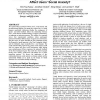75 search results - page 11 / 15 » Self-Explaining Agents in Virtual Training |
IJVR
2008
13 years 11 months ago
2008
The main goals of using simulations and Virtual Environments for Training/Learning (VET/L) are to avoid risks and unwanted consequences, to reduce training costs, and to promote tr...
HCI
2007
14 years 9 days ago
2007
State-of-the-art computer graphics can give autonomous agents a compelling appearance as animated virtual characters. Typically the agents are directly responsible for controlling ...
ATAL
2008
Springer
14 years 26 days ago
2008
Springer
We explored the association between users' social anxiety and the interactional fidelity of an agent (also referred to as a virtual human), specifically addressing whether th...
CHI
2010
ACM
13 years 7 months ago
2010
ACM
Teaching is inherently a social interaction between teacher and student. Despite this knowledge, many educational tools, such as vocabulary training programs, still model the inte...
WSC
2004
14 years 6 days ago
2004
The authors present the requirement definition and methodological approach for developing a new generation of Computer Generated Forces (CGF) based on Intelligent Agents. The anal...

